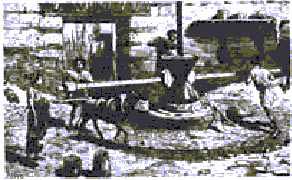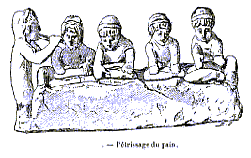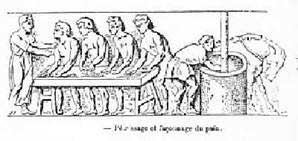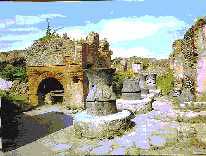 |
[ZAWiW] [gemeinsamlernen] [LiLL] | ||
|
Page 1 of 3
|
|
|
| home | ||
|
|
Gallo-Roman Bread | |
 |
||
Gallo-Roman Bread
Stand:THE GALLO-ROMAN BREAD
A bit of history
1000 years before, the Egyptians already baked their leaven bread, while the
Romans were backward to the Greeks, which were eating a delicious bread as Caton
(234-149 B.C.) said. For the Romans the milling was unknown, baked a leaven
bread and they used pestle and mortar.
Around 380 B.C., the wars in Greece and the invasion of the Gaul learned them to
mill the corn, by hand, or using the wind or water and to use leaven.

Roman hand-mill
The Gallics baked their bread with commun leaven or yeast. already 500 to 600
B.C.
The Bakers
Until the 8th or 7th century B.C., bakeries were of no interest to the Romans, the bread was baked at home, mostly by slaves, kneading the dough, wearing gloves and a mask on their face.
 Kneading dough |
 Kneading and moulding dough |
In 168 B.C., Greek bakers came over to Rome, and the Gallics the remarkable
baker’s assistants.
Around 30 B.C. Rome counted 329 Greek bakeries, assisted by the Gallics.

Bakery at Pompeï
